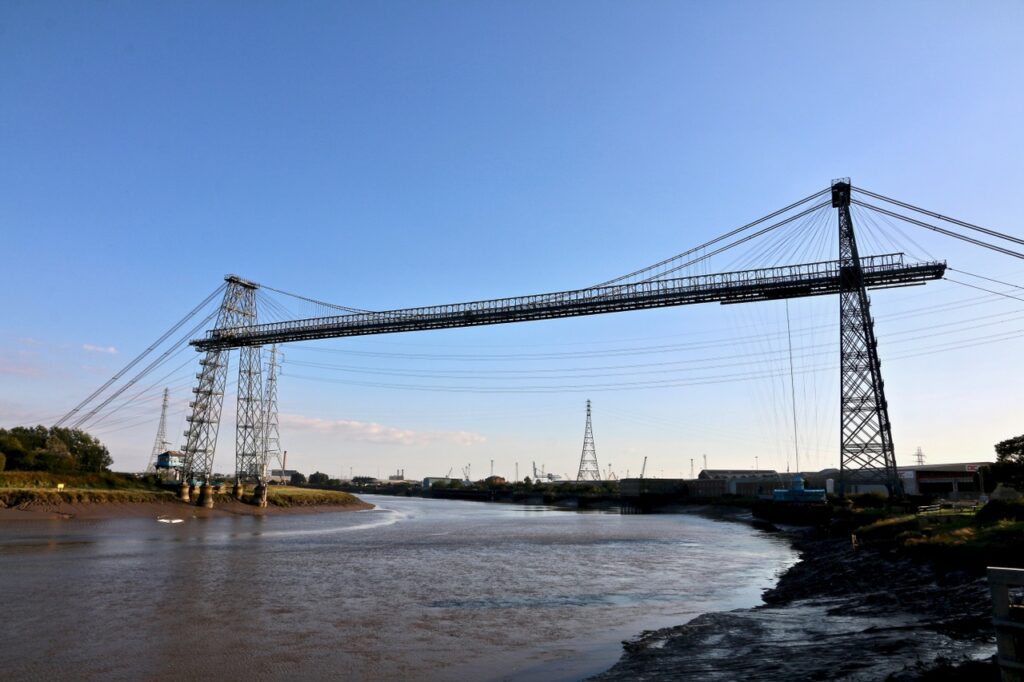Newport Transporter Bridge

THE remarkable Newport Transporter Bridge is one of only six operational transporter bridges left worldwide from a total of 20 constructed.
Parliamentary approval to build the Newport Transporter Bridge was sought and secured in 1900 and work began in 1902.
Haynes and Arnodin were appointed joint engineers and the contract to build the bridge was given to Alfred Thorne of Westminster.
Construction work was completed at a cost of £98,000 and the bridge was opened on September 12, 1906, by Lord Tredegar of Tredegar House, dominating the Newport skyline ever since.
A transporter bridge is basically a suspended ferry that can operate more efficiently than a conventional ferry. A high-level boom that allows ships to pass underneath is suspended from towers at each end.
The boom carries a rail track on which a moving carriage or ‘traveller’ runs. A gondola or platform is suspended from the carriage and can be pulled from one side of the river to the other by means of a hauling cable.
The Transporter Bridge is powered by twin 35-horsepower electric motors.
Although an ‘aerial ferry’ was the idea of English engineer Charles Smith, the first working example was built by Spaniard Alberto Palacio and Frenchman Ferdinand Arnodin in 1893 at Portugalete near Bilbao in Spain.
Historically, in 1900, Newport was a very busy port, much of it centred up-river from where the Transporter Bridge now stands.
Industry was expanding on the east side of the River Usk which, for the population largely based on the west side, meant a four-mile walk to cross the river by the town bridge to get to work.
A ferry operated but the ever-changing times of the tide and its extreme rise and fall meant this was not a practical method of crossing for work – there had also been a number of fatal accidents.
The Borough Engineer, Robert Haynes, had heard of the new innovative bridges being built on the continent and encouraged the council to visit the newly-built transporter bridge at Rouen in France.
A transporter bridge offered an economical solution as tunnelling was technically difficult and expensive and a conventional bridge required a very long approach ramp to gain enough height to maintain a waterway for the tall ships of the day.
Today, the bridge is considered an iconic symbol of the city of Newport, particularly as a mark of its industrial heritage.
As well as a working transport link, the bridge is also open as a tourist attraction – visitors can climb the towers and walk across the upper deck for a small charge. The transporter bridge provided the setting for some scenes in the 1959 British crime drama film Tiger Bay.
The bridge was the focal point of the local millennium celebrations of 2000, where fireworks were fired from its length, and has been featured in several movies and television shows. It was the centre-piece of the Crow Point Festival in September 2006 to celebrate its centenary. It is used for charity events such as sponsored abseils.
The bridge was shut down in 1985 because of wear and tear. Following a £3 million refurbishment, it reopened in 1995. Service was suspended again in December 2008 with the bridge facing a £2m repair bill. £1.225m was spent on refurbishment, financed by grants from the Welsh Government, Newport City Council and Cadw. It re-opened on July 30, 2010.
The Visitor Centre is located on the west bank and features exhibits on the history of the bridge, its construction and other transporter bridges around the world. The centre has a painting of David Pearce, the former undefeated Welsh and British heavyweight boxing champion 1983–1985 who used to run up the steps of the Transporter Bridge during his training.
The centre was closed until Spring 2023 as extensive restoration of the bridge structure began and a new visitor centre is constructed.
A fundraising campaign was held to help carry out repairs to the bridge gondola and ongoing costs of general repairs and maintenance of the bridge. The money raised is being used to build on the successful first-round funding bid from the Heritage Lottery Fund (HLF) which awarded £1 million for the project. The bridge is a Grade I listed structure.
(sources: Newport City Council, Newport Museums & Heritage Service, wikipedia)